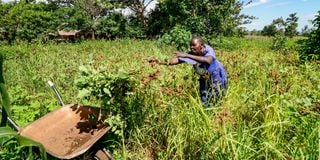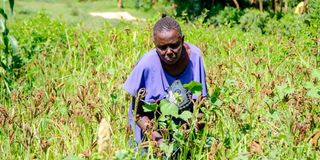Premium
High-yielding millet, sorghum help fight hunger in Migori

Maria Mbusiro weeds her finger millet farm in Masaba Ward, Migori County.
What you need to know:
- Millet and sorghum were consumed widely in the region but have since lost popularity.
- Food experts say most Kenyans now prefer whole grain cereals and indigenous foods.
Seeds of Gold team meets Maria Mbusiro, 40, uprooting weeds at her finger millet farm in Masaba ward, Kuria West constituency, on a cold, muddy Sunday morning. The millet was planted in April. She hopes to harvest in the coming few weeks.
Farming in rural Kenya is a common practice though that was not the case with Mbusiro. She depended on her husband for almost everything and perceived farming as difficult.
When he died after the family had depleted almost all its resources on medical bills, feeding her eight children became a nightmare.
“It was very difficult in the beginning. Even getting flour for porridge was a struggle. We slept hungry for many days. That is now history,” she says.
Mbusiro got a boost 12 months ago when the Kenya Agricultural and Livestock Research Organiaation (Kalro), through a project on providing improved seeds to vulnerable farmers, donated to her a pack of KAK-Wimbi finger millet and Ikinyaruka sorghum seeds.
The seeds, Kalro says, are early maturing and high yielding.
“After we got training on indigenous crop production, I was motivated to get into farming and grow food for my family. I would also make money that would be used to settle my children’s school fees while the remaining would go into savings,” she says.
Millet and sorghum were consumed widely in the region but lost popularity to maize decades ago. Some perceived the two cereals as food for the poor.
Others grew millet and sorghum for porridge. In the process, they inter-cropped the two with cassava. Unfortunately, cassava mosaic disease ravaged the crops.
Mbusiro and many other farmers are reviving these traditional crops in Migori County.

Maria Mbusiro weeds her finger millet farm in Masaba Ward, Migori County.
She was one of the beneficiaries of the improved finger millet and sorghum seeds donation.
Like her neighbour John Menganyi, this is the third time she has grown the millet and sorghum.
“I was given a 2kg packet of millet seeds and another two kilos of sorghum. My first sorghum harvest was three 100kg bags from a quarter an acre. I would have harvested more but birds invaded the farm,” Menganyi says.
Due the scarcity of finger millet and sorghum, the two are more profitable than maize, which is grown by most families.
“A two kilogramme tin of finger millet goes for Sh300. That is four times what maize costs. The same amount of sorghum is Sh150,” Menganyi says.
In April last year, Kalro, the devolved government of Migori and Cornell University, US, provided the improved finger millet and sorghum variety seeds to marginalised farmers in Migori to enhance food security and incomes.
The marginalised groups include the disabled, people with HIV, teen mothers and youth.
“The varieties were produced by Kalro but are now commercialised. They are found in the agro vets and Kalro seed centres,” says Dr Paul Tana, a senior researcher at Kalro.
“The millet has been bred specifically for the strong stalks so that even when grown in waterlogged soil, the plants will not fall”
Food experts say most Kenyans now prefer whole grain cereals and indigenous foods. This has increased demand for finger millet and sorghum.
Dr Simon Omondi, an assistant director at Kalro, encourages more farmers to grow indigenous crops and vegetables, adding that they have a large market.
He says through growing improved varieties of indigenous crops, farmers boost nutrition and help fight hunger.
“Whenever one visited a rural household decades ago, you would see a granary. With a growing population, reduced land sizes for agriculture and climate change, granaries have disappeared,” Dr Omondi says.
By adapting improved seed technology, Mbusiro, Menganyi and other farmers are happy to be recognised in the fight against poverty, hunger and malnutrition.





